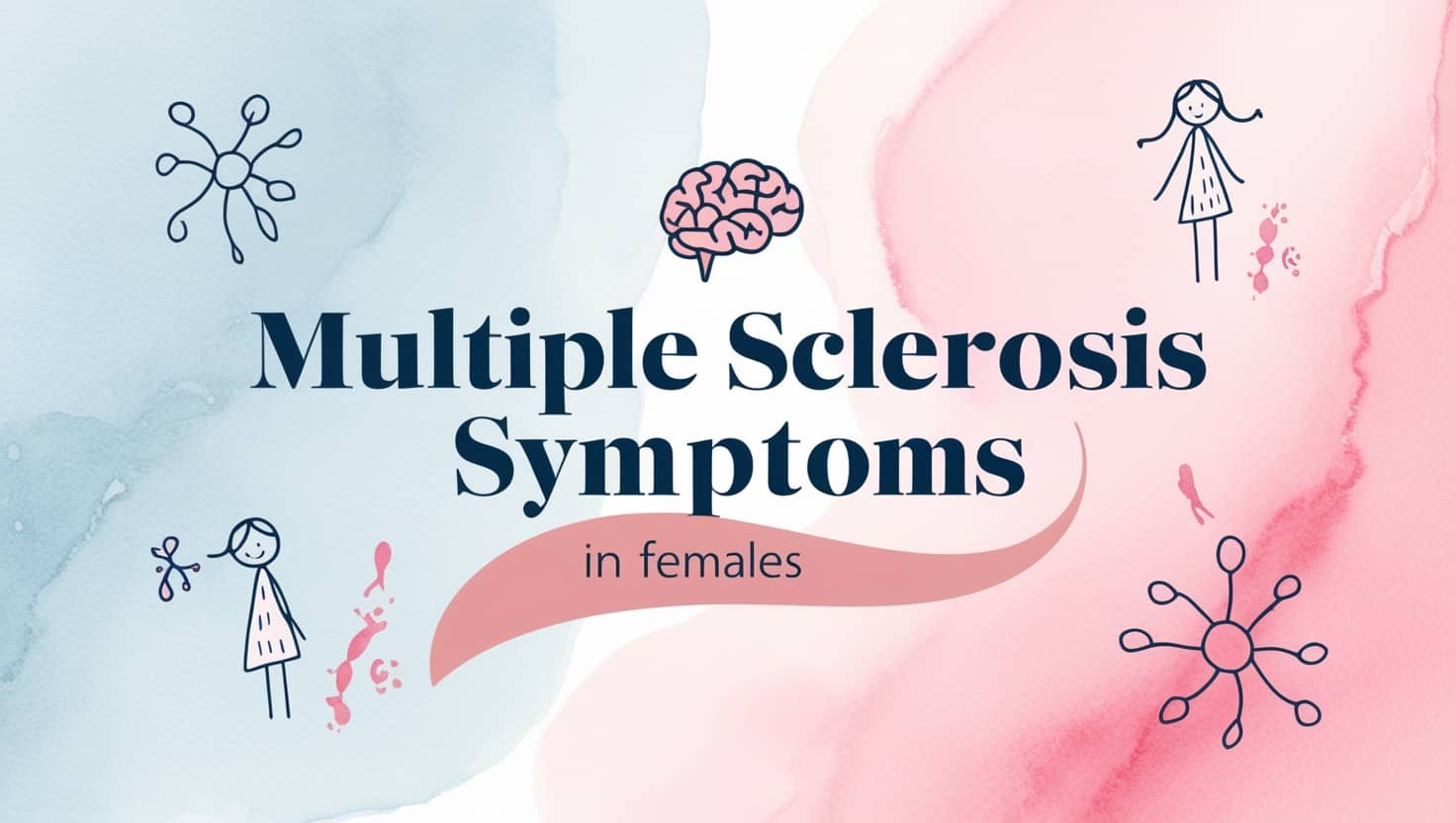Multiple sclerosis (MS) often presents itself subtly in women, with early symptoms that can be easily overlooked.
These initial signs may include tingling sensations in a limb or temporary blurred vision in one eye.
Women are three times more likely than men to develop MS.
This article will explore the most common multiple sclerosis symptoms in females and the early signs, as well as strategies for managing the condition.
Multiple Sclerosis Disease
Multiple sclerosis (MS) is an autoimmune disease that affects the nervous system.
In individuals with MS, the immune system mistakenly attacks the body’s own tissues, specifically targeting the myelin sheath, a protective layer that surrounds nerve fibers.
This attack leads to inflammation and damage to the myelin, disrupting the transmission of nerve signals.
The resulting lesions or plaques on the nervous system can cause a wide range of symptoms, including numbness, weakness, vision problems, and difficulty with coordination.
While genetic factors have long been considered a risk factor for MS, recent research suggests that environmental factors, such as exposure to certain pollutants or vitamin D deficiency, may also play a significant role in the development of the disease.
Symptoms of Multiple Sclerosis in Females
Multiple sclerosis (MS) presents a diverse range of symptoms, making it challenging to predict the exact course of the disease.
This variability arises from the unpredictable nature of the nervous system areas affected by MS.
Symptoms can range from mild to severe and may appear in cycles of relapse and remission.
It’s essential to be attentive to your body, familiarize yourself with potential MS symptoms, and consult with a neurologist for accurate diagnosis and appropriate management.
Multiple sclerosis symptoms in females may include:
- Fatigue: This is a common symptom in cases of multiple sclerosis, which specialists usually attribute to the many responsibilities that women bear.
- Numbness and tingling: This is common in the extremities, and it comes and goes at intervals.
- Difficulties in vision: Feeling pain when moving the eye is one of the signs of the disease.
- Weakness: especially one that affects one side of the body and then disappears and returns.
Other common symptoms include:
- Muscle issues: Muscle spasms, stiffness, and a sensation of tightness around the torso, often referred to as an “MS hug,” due to spinal cord nerve damage.
- Sensory disturbances: Pain, tingling, or numbness in various parts of the body.
- Bladder dysfunction: Frequent urination, urgency, or incontinence.
- Sexual dysfunction: Difficulties with sexual arousal or performance.
- Bowel problems: Constipation resulting from digestive system involvement.
Multiple sclerosis can also affect cognitive function and motor skills.
Symptoms may include depression, difficulty with thinking, memory problems, and trouble finding the right words.
Additionally, individuals with MS may experience tremors, muscle spasms, and swallowing difficulties
Early Signs of MS in Women
Multiple sclerosis can cause a wide range of symptoms, including:
- Fatigue.
- Numbness or tingling (paresthesia).
- Blurred vision.
- Sexual dysfunction.
- Cognitive problems.
- Urinary incontinence.
- Pain
- Muscle spasms.
- Bladder and bowel dysfunction.
- Walking difficulties, dizziness and balance problems.
- Depression.
- Constipation.
- Muscle weakness.
- Tremor.
- Slurred speech.
- Double vision.
- Mood changes.
- Difficulty swallowing (dysphagia).
- Hearing loss.
- Lack of coordination, and muscle weakness or spasms.
What Causes Multiple Sclerosis in Females
Multiple sclerosis predominantly affects women, with new cases diagnosed daily.
While the exact causes remain unclear, several factors are known to increase the risk:
- Smoking
- Obesity
- Stress
- Inflammation
- Vitamin D deficiency
- Female hormones. (Goldenberg, Multiple Sclerosis Review, 2012)
Female factors that can contribute to the development of multiple sclerosis
- Female hormones
are believed to play a role in the development of multiple sclerosis.
This is supported by the observation that the disease risk is similar between boys and girls before puberty.
However, after puberty, women are three to four times more likely to develop MS than men.
- Pregnancy
Pregnancy can have a surprising effect on multiple sclerosis. Many women with MS report a reduction in symptoms during pregnancy.
However, after childbirth, symptoms often worsen. Despite this, women with MS can have healthy pregnancies and deliver healthy babies.
It’s important to monitor the growth and nutrition of these children to ensure they reach healthy weight milestones and reduce their risk of developing health problems.
- Obesity and fat storage
Obesity is a significant risk factor for multiple sclerosis.
Obesity is associated with inflammation, and women, who tend to have higher body fat percentages than men, may be particularly susceptible.
Additionally, pregnancy can lead to increased visceral fat storage in women.
Some research suggests that women’s bodies may respond differently to infections, producing potentially harmful substances that may contribute to the development of MS.
- Vitamin D deficiency
Vitamin D deficiency is linked to an increased risk of multiple sclerosis.
People living farther from the equator, with less sun exposure, are more likely to be deficient in vitamin D, and have a higher risk of developing MS.
Conversely, individuals who spend more time outdoors, such as farmers and gardeners, have a lower risk of developing MS. Additionally, studies have shown that supplementing with vitamin D can significantly reduce MS symptoms.
Multiple Sclerosis Lifespan
Long-term studies have shown that individuals with multiple sclerosis have a life expectancy that is approximately 7.5 years shorter than those without the disease.
The average lifespan for people with MS is around 75.9 years.
Read Also: What Causes a UTI in a Woman?
Multiple Sclerosis Medications List
Multiple sclerosis treatment medications aim to do two things:
- Treat relapses with some medications such as corticosteroids or plasma exchange.
- Slow the progression of the disease, and reduce relapses such as Mayzent, Copaxone, Avonex, Glatopa and others. (Hauser & Cree , 2020)
Relapses treatment
Relapse medications treat infections to shorten their duration and improve their symptoms.
Among these medications are: Prednisone and dexamethasone.
In severe cases, a plasma exchange is performed to remove antibodies from the blood.
Treatments that slow the progression of the disease and reduce relapses
The most important of these treatments are:
Injections: Interferon beta injections such as Avonex.
Oral: Teriflunomide, dimethyl fumarate, diroximel fumarate, monomethyl fumarate, cladribine, ponesimod, and cladribine.
Infusion: Such as ocrelizumab, alemtuzumab, and natalizumab
Other specialized treatments
Other specialized treatments may be prescribed to manage specific symptoms of multiple sclerosis.
These treatments can include:
Antidepressants: Selective serotonin reuptake inhibitors (SSRIs) may be used to alleviate depression.
Muscle relaxants: Baclofen can help reduce muscle spasms.
Stimulants: Modafinil may be prescribed to combat fatigue.
Anticonvulsants: Gabapentinoids can help manage pain.
List of the medications grouped by their primary mechanism of action:
Disease-Modifying Therapies (DMTs):
- Interferon Beta Medications: Rebif, Avonex, Betaseron and Extavia
- Glatiramer Acetate: Copaxone and Glatiramer
- Dimethyl Fumarate: Tecfidera, Vumerity, Dimethyl Fumarate and Diroximel Fumarate.
- Monoclonal Antibodies: Ocrevus, Tysabri, Kesimpta, Ocrevus, Zunovo, Ublituximab and Ofatumumab.
- S1P Receptor Modulator: Gilenya
- NMDA Receptor Antagonist: Aubagio
Symptom Management Medications:
- Ampyra: Ampyra
- Corticosteroids: Prednisone
- Sodium Channel Blocker: Dalfampridine
Combination Therapy: Briumvi
Read Also: Kidney Stones Symptoms in Women
Key Notes
While this is a general categorization of MS medications, the specific treatment plan for each individual may vary based on factors like disease severity and personal needs.
It’s essential to consult with a healthcare professional for tailored advice and guidance.
We hope that you have found all the information that interests you about the symptoms of multiple sclerosis in females, the causes of the disease and possible treatment methods.
References
Goldenberg, M. M. (2012). Multiple Sclerosis Review. PubMed.
Hauser , S. L., & Cree , B. A. (2020). Treatment of Multiple Sclerosis: A Review.







